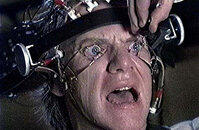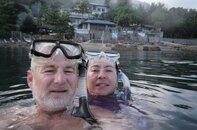You are using an out of date browser. It may not display this or other websites correctly.
You should upgrade or use an alternative browser.
You should upgrade or use an alternative browser.
Wearing mask backwards on forehead
- Thread starter oahu_diver
- Start date
Please register or login
Welcome to ScubaBoard, the world's largest scuba diving community. Registration is not required to read the forums, but we encourage you to join. Joining has its benefits and enables you to participate in the discussions.
Benefits of registering include
- Ability to post and comment on topics and discussions.
- A Free photo gallery to share your dive photos with the world.
- You can make this box go away
R
redacted
Guest
My mask is either in a protective container (often a fin foot pocket), backwards on my forehead as I prepare for an entry, or on my face. I have yet to see a mask damaged in any of those locations.
The bungied second should be at a point that one may get it positioned without the use of one's hands. Hand off the primary, dip head, breathe out to clear, breathe in.
Are you using one of the puck types?
I never heared that before; the dip you head to reach the bungied 2nd, w/o using your hands idea. ;hm:
I will have to try it next time I am diving. Thanks.
I do find the spacing a bit tight, wearing the mask on my neck, and the bungied 2nd, but I like the extra security that having the mask securely around my neck provides.
William Gordon
Guest
I was taught in my PADI OW and AOW just last year to never put your mask on your forehead because its a sign of distress. Putting it on backwards is easier than pulling it down to your neck and safer than holding it.
I was taught the same thing two days ago
I was taught the same thing two days ago
Welcome aboard!
So, yes PADI taught this as a sign of distress. The real reason is that it can be easily knocked off in swell or kicked off by someone elses fins, hands etc... I often put mine on my forehead in calm water but only because I hate it around my neck.
DevonDiver
N/A
So, yes PADI taught this as a sign of distress.
Why do people keep saying this? A PADI instructor saying something, isn't the same as it being a formal PADI protocol.
Here's exactly what PADI say on it...
PADI Instructor Manual, Rescue Diver Course, Presentation Notes:
16. If the diver’s reaction does not solve the problem and the diver feels unable to correct the problem, the result may be sudden, unreasoned, instinctive panic, and the need for rescue. Panic takes two forms: a. Active behavior – mask off, regulator/snorkel out, grabbing, struggling or bolting.
b. Passive behavior – frozen, trancelike, unaware or unresponsive.
. Recognizing Rescue Situations
What signs and behaviors indicate a diver may have a problem at the surface?a. The signs exhibited by a diver needing assistance are often subtle. An exhausted diver at the surface may suddenly and quietly slip under for no apparent reason. A diver with a problem will often fail to ask for help.b. It is possible that ego threat may keep a diver from expressing anxiety, illness, or other distress to dive buddies or to others.c. Scuba diving equipment often conceals facial expressions and other gestures that indicate stress or anxiety, and it reduces the possibility of verbal communication.d. Signs of distress often are not always easy to recognize, but consider the following behaviors as trouble indicators:1. Giving distress signals – raising one arm, whistling, yelling for help, and so on.2. Struggling on or just below the surface, especially with vigorous arm swimming.3. High treading or finning with sufficient vigor to lift a portion of the body and equipment out of the water.4. Rejecting equipment by pushing off the mask and/or the regulator mouth piece, or both.5. Clinging and clambering (pulling the body toward the high point of any object on the surface).6. Not moving – apparent unresponsiveness.
"Mask off".
...not "Mask carefully repositioned onto the forehead".
The fact that this is misinterpreted by some PADI instructors does nothing but prove they are simply regurgitating training, without the additional benefit of any real experience or foresight in emergency management.
blue steal
Contributor
- Messages
- 2,802
- Reaction score
- 414
- # of dives
- 500 - 999
View attachment 101036
Snorkeling in Anialo, Philippines. Masks on forehead.
You must be in distress, fly me in and I'll save you!
A ScubaBoard Staff Message...
Similar threads
- Replies
- 36
- Views
- 5,777
- Replies
- 13
- Views
- 649
- Replies
- 8
- Views
- 6,577
- Replies
- 31
- Views
- 3,566
- Replies
- 20
- Views
- 1,890





